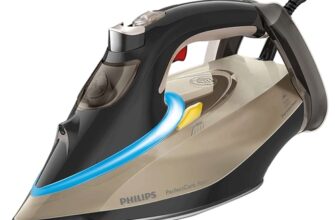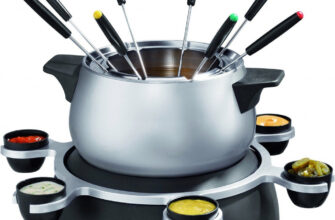When choosing a dishwasher, you should pay attention to its technical and operational characteristics.
- content
- How to choose a dishwasher: selection criteria
- Should you buy a dishwashing machine
- Types of dishwashers – what they are
- type of instalation
- Built-in dishwashers
- Advantages
- disadvantages
- Partially built-in dishwashers
- Advantages
- disadvantages
- Freestanding dishwashers
- Advantages
- disadvantages
- Dishwasher size
- The main criteria for choosing a dishwasher
- Water consumption
- Energy class
- Washing class
- Control type
- Mechanical control
- Advantages
- disadvantages
- Electronic control
- Advantages
- disadvantages
- Operating modes
- Dishwasher Drying Types
- Condensing Drying
- Advantages
- disadvantages
- Turbo drying
- Advantages
- disadvantages
- Connection features
- Leakage protection
- Filters available
- Additional features
- How to choose the right dishwasher
- How much does a dishwasher cost
- Top dishwasher manufacturers
- Dishwasher selection video
content
- How to choose a dishwasher: selection criteria
- Should you buy a dishwashing machine
- Types of dishwashers – what they are
- The main criteria for choosing a dishwasher
- Dishwasher Drying Types
- Additional features
- How to choose the right dishwasher
- How much does a dishwasher cost
- Top dishwasher manufacturers
- Dishwasher selection video

How to choose a dishwasher: selection criteria
When choosing, you should pay attention to the following parameters of the dishwasher:
-
Installation type (built-in, partly built-in, free-standing machine);
-
Size (narrow, compact, full size);
-
Water consumption and consumption class;
-
Number of programs;
-
Connection type (to cold or hot water supply);
-
Leakage protection;
-
Filtration system;
-
Additional functions.
-
Manufacturer.
Should you buy a dishwashing machine
If more than one person lives in the house – yes, it is. Especially if the family has a small child. The amount of dirty dishes grows exponentially depending on the 'population' of the house – that is, two people can stain 3-4 times more plates and forks than one.
Therefore, installing a dishwasher can save time, effort and even reduce water consumption for hygiene procedures.
Types of dishwashers – what they are
There are two criteria by which to group existing washing machines – installation type and size.
type of instalation
According to the type of installation, dishwashers are divided into built-in, partially built-in and free-standing.
Built-in dishwashers
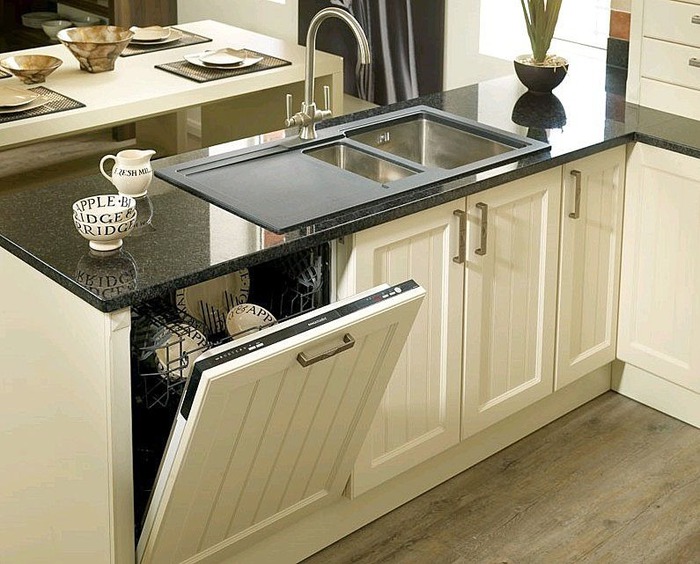
The design of fully built-in dishwashers means that they do not have their own façade, and the furniture panel serves as a replacement for the outer decorative shell. Therefore, such devices do not stand out at all from the rest of the kitchen set.
Advantages
-
Completely invisible in the kitchen set;
-
Often less expensive than partially built-in or full-size;
-
They can be decorated with panels of any color and type, so you don't have to buy a new car when changing kitchen furniture;
disadvantages
-
The installation of a dishwasher should be planned even at the stage of choosing or ordering a kitchen set;
-
Slightly more difficult access to internal functional elements for repair or service
The most serious disadvantage of built-in dishwashers is that they cannot be purchased 'on demand' or 'on demand'. The installation of such a device will have to be planned in advance, even at the stage of selecting a kitchen set and carrying out engineering communications – in order to ensure water supply and connection to the sewer.
Partially built-in dishwashers

Such dishwashers differ from fully built-in ones by having their own façade. Therefore, they 'stand out' from the rest of the kitchen set.
The facade of partially built-in machines can be made of plastic or metal. The first one is easier to wash from various contaminants, but it is also easily scratched. The second is more difficult to maintain, but it has an attractive appearance and is resistant to various damages.
Partially built-in dishwashers are the most common type.
Certain models of partially built-in dishwashers can be 'converted' into fully built-in dishwashers by hanging their own furniture panel facade.
Advantages
-
Variety of models available;
-
In most cases, laconic and modern design.
disadvantages
-
They stand out from the kitchen set, as a result of which they can spoil the design composition;
-
Practicality is influenced by the material from which the facade is made.
Freestanding dishwashers
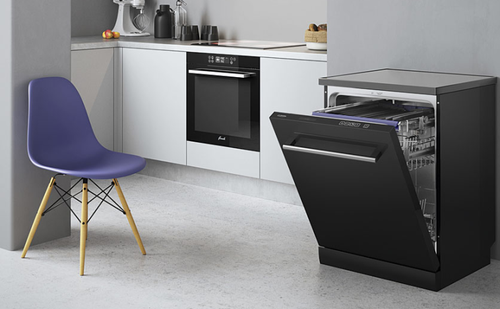
Freestanding dishwashers are not designed to be installed in kitchen units. They are equipped with a decorative outer casing that allows them to be placed anywhere.
In some cases (when there is no room in the kitchen set for installing an additional module or when access to communications is difficult), these machines are the most optimal solution.
Advantages
-
Ease of installation (no need to make tie-ins in engineering communications in advance);
-
Easy access to all functional elements for repair and maintenance.
disadvantages
-
Often higher noise or vibration levels than built-in models;
-
They stand out from the kitchen unit and take up space in the room.
Dishwasher size
A parameter such as size serves as a selection criterion exclusively for built-in dishwashers of both types. Indeed, free-standing 'a couple of extra centimeters' will not be a problem. But a car that is too fat simply will not fit into a kitchen set.
There are three standard dishwasher sizes:
-
Compact – height 45 cm, width 55 cm, depth 45 cm;
-
Narrow – height 82 cm, width 45 cm, depth 57 cm;
-
Standard – height 60 cm, width 60 cm, depth 85 cm.
It is worth remembering that for manufacturers these parameters are of a recommendation nature, therefore the specific dimensions of the dishwasher may differ by several centimeters.
The size of a dishwasher directly determines its capacity. So, compact models are designed for 4-6 sets of dishes and therefore are suitable for daily use in a small family of 2-3 people. The narrow one will include up to 10 sets, and the standard one – from 12 sets. Therefore, it is worth choosing the size of the dishwasher based not only on the size of the kitchen unit (where it is planned to be built in), but also on the number of 'users'.
When choosing a freestanding dishwasher, its capacity becomes the prevailing value.
The main criteria for choosing a dishwasher

Among the most important design features that determine the practicality of a dishwasher are:
-
Water consumption and energy class;
-
Washing class;
-
Control type;
-
Operating modes and the number of preinstalled programs;
-
Connection type;
-
The presence of protection against leaks;
-
The presence of filters.
Water consumption
This parameter determines how much water the dishwasher will use up during a complete cycle of operation, including a pre-wash (for some models), a main wash and a rinse. It depends on the specific model of the device, the installed program, dimensions, year of manufacture and many other parameters. Therefore, it is not possible to determine the recommended value.
Most modern compact dishwashers have a water consumption of 6-8 liters for a full wash cycle, for narrow ones – 8-10 liters, for standard ones – 10-14 liters.
There are also ultra-economical models – for example, standard ones with a consumption of about 6 liters per wash cycle. But they are expensive.
For urban conditions, the type of water used in the car is also important – hot (expensive) or cold (relatively cheap). In the latter case, the device heats the liquid on its own. Of course, this consumes electricity. Therefore, it is worth paying attention to the energy consumption of the dishwasher.
Energy class
Energy class refers to the current consumption of the dishwasher per cycle. The higher it is, the better. Energy consumption classes are designated by Latin letters, where A is the most economical, and G is the most energy consuming.
The specific values are as follows:
-
G – from 2.7 kW;
-
F – 2.5 kW;
-
E – 2.2 kW;
-
D – 2 kW;
-
C – 1.5 kW;
-
B – 1.1 kW;
-
A – up to 1.07 kW.
Some modern dishwashers have an energy rating of A + or A ++, which consumes even less electricity.
However, the lower the energy consumption of the dishwasher, the more expensive it is. Therefore, you should not chase ultra-efficient models, even class C devices are suitable for home use.
Washing class
Washing class is a parameter that shows how well the machine copes with dirt on dishes. It is also denoted in Latin letters, where A is the best work and maximum safety.
The quality of the wash is directly influenced by the number and location of nozzles and nozzles. The more of them, the better the machine copes with dirt.
Control type
Dishwasher controls can be mechanical or electronic.
Mechanical control
Mechanical control involves equipping the device with appropriate switches and buttons. It is durable, but not very functional.
In modern dishwashers, mechanical control is practically not found. It can only be found in very budget models or special ultra-compact versions, with dimensions similar to a microwave.
Advantages
-
Durability (expressed in terms of functionality independent of humidity or electricity stability);
-
Simplicity.
disadvantages
-
Extremely poor functionality;
-
Large dimensions of the control module, affecting the size of the device or usable volume;
-
Lack of programs;
Electronic control
Electronic control is the de facto standard for modern dishwashers. It allows you to set a variety of automatic work programs for maximum practicality or economy.
Advantages
-
Wide functionality – many modes and automatic programs;
-
Relative ease of setup (for some models);
-
Compactness of the module;
disadvantages
-
High sensitivity to harmful influences of the external environment (humidity, voltage drops);
-
The risk of inadequate operation of the device in case of problems with the firmware.
Operating modes
The modes of operation determine the practical qualities of the device. Among them, the following can be distinguished as the most important:
-
Pre-wash mode – designed to remove very stubborn dirt, including dried and greasy. In it, the dishes are simply poured over with water without the addition of chemicals and are 'soaked' for some time;
-
Main wash mode – directly removing dirt from the surface of the dishes. In it, water is alternately applied to the surface of the plates with a special agent and without it;
-
Rinse mode – designed to rinse the remaining cleaning agent from the surface of the dishes;
-
Drying mode – it removes moisture from the surface of the dishes.
Dishwasher Drying Types
The drying mode itself can be implemented in two ways – condensation and turbo drying.
Condensing Drying
Condensation drying means removing moisture from the surface of the dishes in a natural way – it simply evaporates from there and settles on the inner walls of the dishwasher.
Advantages
-
Low power consumption dishwasher;
-
Low device price;
-
Less requirements for water quality;
-
Low risk of damage to any elements of the dishwasher by condensation;
disadvantages
-
It takes a very long time, up to several hours;
-
Risk of stains on dishes.
Turbo drying
Turbo drying involves blowing hot air through the dishes through nozzles or a special fan in the dishwasher. If the speed of drying dishes is important, you should choose a model equipped with a turbo drying mode. If this parameter is not important, machines with condensation dryers will do.
Advantages
-
High speed of drying dishes;
-
Lack of divorces.
disadvantages
-
Expensive dishwasher;
-
Increased power consumption.
Connection features
Dishwashers can only be connected to cold or both cold and hot water. Moreover, the first type of installation is preferable.
When connected only to cold water, the dishwasher independently heats it to the desired temperature, due to which the cost of utility bills (hot water is usually much more expensive) are reduced. In addition, this option is much easier to install. And also the quality of dishwashing does not depend on the preventive work of public utilities.
The only drawback of this connection option is that the heating element 'eats away' the usable space of the main compartment of the dishwasher.
When connected to cold and hot water, the dishwasher does not heat up anything on its own. This reduces electricity consumption slightly. But the installation becomes more complicated.
Leakage protection
Protection against leaks is realized through a special sensor located in the dishwasher pan. Most often, it has a simple float configuration and is triggered as soon as a sufficient amount of water is collected in the bottom (usually 0.2 l).
The protection system can be of two types – full and partial.
-
For dishwashers with partial leak protection, the water shut-off valve is located directly in the housing. It is he who is triggered after the 'panic' signal of the float sensor.
-
For fully leakproof dishwashers, this valve is located at the end of the hose. Thus, they are protected from depressurization of engineering communications and therefore much safer. But also more expensive.
Filters available
Dishwashers are equipped with filters of various types – from inlet, designed to soften water, to weekend, which purify waste water before feeding it into the recirculation system.
The more different filters, the better. For example, input lengthens the life of the dishwasher by reducing the risk of limescale build-up in the nozzles and on the heating element. The outlet filters mechanically purify the waste water by removing food particles from the plates.
The only drawback of filters is that they need to be cleaned regularly and in some cases even changed.
Additional features
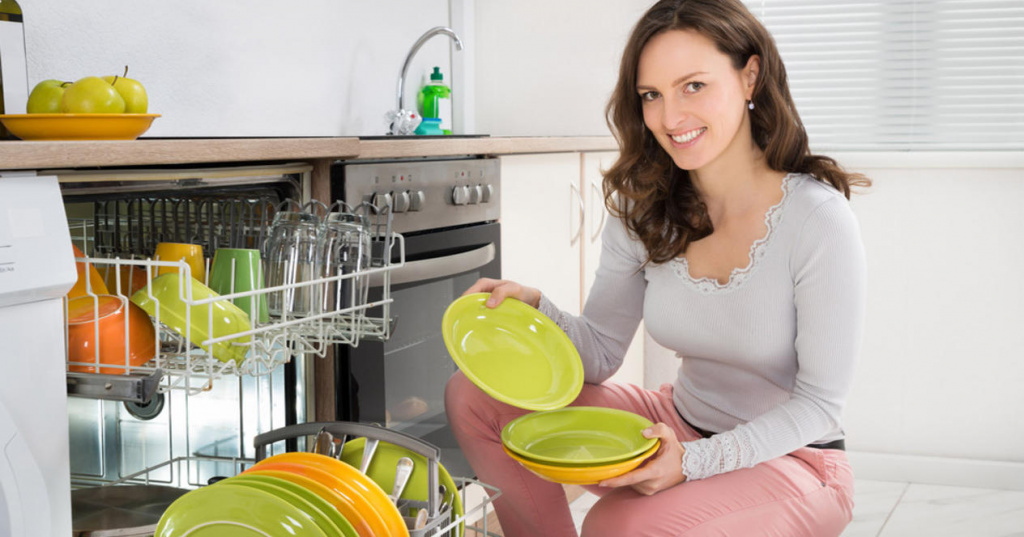
Additional features that determine the practicality of the dishwasher include:
-
The half load mode is suitable for relatively small amounts of dishes. Despite the fact that the procedure time is not reduced, the water consumption is reduced by about 30%.
-
The quick wash mode, as the name implies, reduces the processing time of dishes by about 30-50% by reducing the duration of each stage of the cycle. Suitable for handling not too dirty cutlery.
-
The intensive wash mode is designed to remove difficult dirt. It increases the amount of cleaning agent and water pressure from the nozzles. It is clear that this also leads to a slightly increased energy consumption, but it allows you to cope even with very dry or stubborn dirt.
-
The delicate wash mode is intended for cleaning dishes that are sensitive to temperature and mechanical stress, such as crystal glasses. In it, the water becomes less hot, and the intensity of its flows decreases.
-
The economy program and the BIO program reduce the consumption of tap water by increasing the use of liquid from the recirculation system. Not suitable for tough dirt removal.
-
Childproof lock eliminates accidental or uncontrolled pressing. To set the operating parameters, as well as just turn on the dishwasher, you will need to perform some complex actions (for example, hold down and hold two buttons for a while).
How to choose the right dishwasher
Choose a dishwasher according to the following method:
-
Determine the type of placement (built-in or free-standing);
-
Determine the required size (compact, narrow, standard);
-
Select the desired operating modes and preinstalled programs;
-
Determine if the selected dishwasher is suitable for its technical characteristics.
Ergonomics is also important, but it can only be determined in the store – and it is different for every person.
How much does a dishwasher cost
The cost of dishwashers directly depends on functionality, type and volume. It starts from 10 thousand rubles and ends with several hundred thousand rubles. But the vast majority of models designed for home use are in the optimal price range of 25-40 thousand rubles.
Top dishwasher manufacturers
Among dishwasher manufacturers, one of the best is the German concern B / S / H, which produces household appliances under the brands Bosch and Siemens. In addition, quality models can be found at Whirlpool, Miele and Electrolux. In the budget segment in terms of characteristics and durability, the products of the Candy company are in the lead.
!
In the following articles, our experts tell you how to choose the right refrigerator for your apartment and the secrets of choosing a washing machine.
Dishwasher selection video
Attention! This material is the subjective opinion of the authors of the project and is not a purchase guide.


